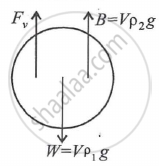Advertisements
Advertisements
प्रश्न
A spherical solid ball of volume V is made of a material of density ρ1. It is falling through a liquid of density ρ2 (ρ2 < ρ1). Assume that the liquid applies a viscous force on the ball that is proportional to the square of its speed v, i.e., `"F"_"viscous"`= -kv2 (k > 0). The terminal speed of the ball is ______.
पर्याय
`sqrt(("Vg"(rho_1-rho_2))/"k")`
`("Vg"rho_1)/"k"`
`sqrt(("Vg"rho_1)/"k")`
`("Vg"(rho_1-rho_2))/"k"`
उत्तर
A spherical solid ball of volume V is made of a material of density ρ1. It is falling through a liquid of density ρ2 (ρ2 < ρ1). Assume that the liquid applies a viscous force on the ball that is proportional to the square of its speed v, i.e., `"F"_"viscous"`= -kv2 (k > 0). The terminal speed of the ball is `underlinebb(sqrt(("Vg"(rho_1-rho_2))/"k"))`.
Explanation:
The condition for terminal speed (vt) is Weight = Buoyant force + Viscous force

∴ Vρ1g = Vρ2g + k`"v"_"t"^2`
∴ vt = `sqrt(("Vg"(rho_1-rho_2))/"k")`
